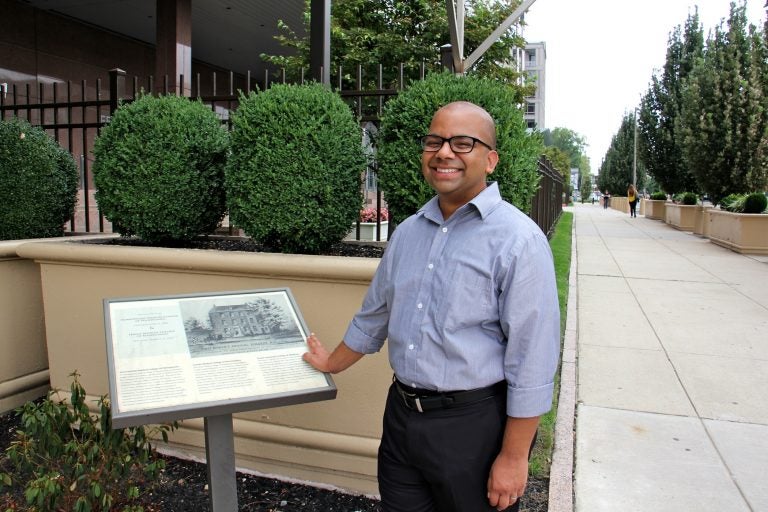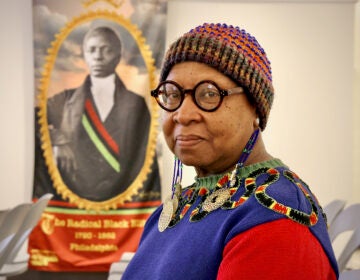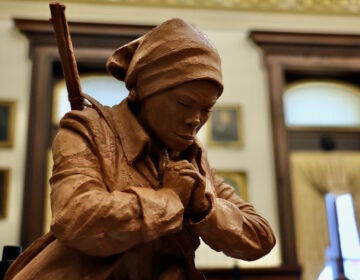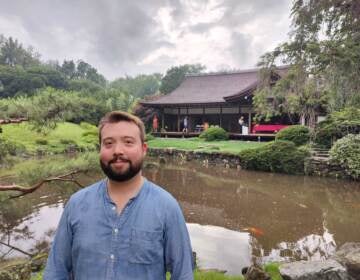Coming soon: Audio walking tour of Philly’s South Asian history, set to new music
This fall, discover a new self-guided audio walking tour of Old City that uncovers hidden stories of South Asians in Philadelphia.
Listen 1:38
Samip Mallik, director and co-founder of the South Asian American Digital Archive, stands at 6th and Arch streets, the former site of the Female Medical College of Pennsylvania. (Emma Lee/WHYY)
There is a historical plaque on the sidewalk at the corner of 6th and Arch streets in Center City. The Federal Reserve Bank sits there now, but it used to be the site of the Female Medical College of Pennsylvania, opened in 1850 as one of the only places in the world where a woman could study to become a physician.
The plaque says “thousands of practitioners from all parts of the country and the world trained there, including hundreds of international medical missionaries.”
What it does not say is that one of those international students was Anandibai Joshee, the first woman doctor in India. She traveled to Philadelphia to study in 1883, and in doing so rebelled against both the Indian tradition of not educating women and against American values by adamantly refusing to become westernized.
“Before she left, she made a rousing speech to declare that she would refuse to accept American customs when she arrived in America,” said Samip Mallick, director and co-founder of the South Asian American Digital Archive (SAADA). “She would continue to dress and eat as she did in India, which obviously was very challenging to do in the late 1800s.”
SAADA is a digital archive created 11 years ago to collect and preserve artifacts related to South Asian America, including home movies and audio.
Joshee graduated, received a personal note of congratulations from Queen Victoria, and returned to India in 1886 a hero intent on practicing medicine.
Tragically, Joshee died shortly thereafter at age 21 from tuberculosis, which she had contracted while in America.
Joshee’s story is part of SAADA’s South Asian history tours, which began last spring as personally guided walks through Old City. Participants follow a storytelling leader, stopping at seven key points to hear about South Asian’s contributions to American history.
The tours will continue this fall with a new addition: The stories will also be available as downloadable sound files for self-guided tours, accompanied by original songs commissioned for the project. While the launch date of the new audio walking tour is TBD, all four musicians will be in Philadelphia on Saturday evening to perform at Christ Church Neighborhood House.
Writing ‘South Asian Americans into the landscape’
The tour starts at the Liberty Bell — which was the site of a major demonstration in the 1920s calling for India’s independence from the British empire — loops through points along Independence Mall, snakes through Elfreth’s Alley, and ends at the Race Street Pier.
“We want to demonstrate that this part of the city — which most people don’t associate with people of color, immigrants, or women — actually have always included those people from the earliest days,” Mallick said. “We want to write South Asian Americans into the landscape of the American republic.”
The tour includes Pandita Ramabai, an influential social reformer and activist who came to Philadelphia to watch Joshee, her cousin, graduate from medical school. She stayed in Philadelphia for a short time and went on to travel through America for two-and-a-half years.
In addition to her most well-received book, “High-Caste Hindu Woman,” she also wrote a travelogue about her time in America. It included anecdotes about encountering strange American customs (her boarding hosts were offended that she dared to go barefoot indoors in the summertime) and being deeply impressed by the country.
“The happiness I derived from seeing the marvelous things in the United States will remain incomplete unless I share it at least in some measure, with my dear countrymen and –women,” Ramambai wrote in “The People and Travels of the United States” (1889).
The stories of those two women – Ramabai and Joshee – are the basis of a song by the Boston-based singer-songwriter, Anju Madhok, whose stage name is simply Anju.
Under commission from SAADA, she wrote a pop-inflected tune, flush with the elation of blazing a trail in an unknown land.
“Say what they will about my bare feet,
I traded lush lands for new sands.
I see their false teeth.”
SAADA asked a wide range of musicians to contribute original music, including the hip hop of Mandeep Sethi (Seti X), the minimalist synthesizers of Arooj Aftab, the art-rock of Zain Alam, and jazz saxophonist Rudresh Mahanthappa.
Mahanthappa’s jazz trio responded to the story of Amar Bose, the electrical engineer who founded the Bose sound equipment company in 1964 in Massachusetts. Bose was born in Philadelphia, the son of a revolutionary who fled India in the 1920s for fear of persecution, and continued fighting for India’s independence from the British empire from his new home at 18 S. 7th Street (what is now Constitution High School).
Documents related to the people and places on the walking door are available at SAADA.
Asking artists to use the digitized archive as creative fodder is part and parcel of SAADA’s mission.
“Reading a letter in the archive might affect you one way, but hearing a song or seeing a painting made from that letter might impact you in a completely different way,” Mallick said. “As we all know, art really changes the impact of stories and histories on people.”
WHYY is your source for fact-based, in-depth journalism and information. As a nonprofit organization, we rely on financial support from readers like you. Please give today.





